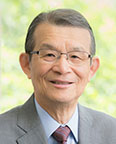- HOME
- Research
- Researcher's Profile
- Teruo KISHI
Researcher's Profile

- Fellow
- Teruo KISHI
- RCAST Fellow
Biography
| April 1969 | Associate Professor, Assistant Professor, Professor, RCAST, the University of Tokyo (UTokyo) |
|---|---|
| April 1995 | Director, RCAST, UTokyo |
| April 1997 | Diector, Interdisciplinary Institute Agency of Industrial Science and Technology of Advanced Industrial Science and Technology |
| May 2000 | Professor Emeritus, UTokyo |
| April 2001 | President, National Institute for Materials Science |
| July 2003 | Vice President, Science Council of Japan |
| April 2007 | President, The Japan Federation of Engineering Societies |
| July 2009 | Advisor, National Institute for Materials Science |
| October 2013 | President, Innovative Structural Materials Association (ISMA) |
| December 2013 | Special Advisor to the Cabinet Office for Science, Technology and Innovation |
| September 2015 | Science and Technology Advisor to the Minister for Foreign Affairs |
| March 2019 | Fellow, RCAST, UTokyo |
Research Interests
In the fields of aerospace, drone vehicles, robotics, and electric automobiles which are facing the problem of battery weight gain, the development of light weight structural materials is strongly demanded. Generally, the material loses ductility and toughness as it gains strength. This inconsistency can be resolved by fail-safe materials where formation of microcracks releases local stress and avoids macroscopic final fracture.
These microcracks prior to macroscopic crack growth can be detected with acoustic emission (AE) techniques, and the materials with improved fracture toughness were found when more microcracks were detected. In metals and ceramics, microcracking can be controlled by dispersing fine brittle particles and by introducing inhomogeneous microstructure without losing high strength of the material. In terms of composite materials, it is important to add brittle particles to the matrix and to control the interfaces between fibers and matrix.
Based on this idea, by introducing needle-like structure and inhomogeneously-dispersed particles, the materials with high strength and high toughness have successfully been developed for titanium alloys and ceramic matrix composites. Recently, by further application of this concept, high-tensile strength steel with the strength of 1.5-1.8 GPa, ultra super duralumin with the strength of 800 MPa, high-strength and high-toughness carbon fiber reinforced plastics (CFRP), and other materials are being developed without losing ductility and toughness, and that has led to the development of new materials for automobiles and aircrafts. These are being applied to the society and contribute a lot to strengthen international industrial competitiveness.
One of the responsibilities for the Science and Technology Adviser to the Minister for Foreign Affairs of Japanese Government is to build up a network of human resources. Japanese advanced science and technology can solve various issues of industrializing nations through bilateral cooperation, and can cope with global problems by leading international cooperation. And then, the status of Japan will be enhanced when the achievements can be used as diplomatic resource. With international joint scientific research, scientists and engineers of the partner countries will be developed, which forms basis for sustainable growth, and that is consistent with Japanese policies for development aid.
These microcracks prior to macroscopic crack growth can be detected with acoustic emission (AE) techniques, and the materials with improved fracture toughness were found when more microcracks were detected. In metals and ceramics, microcracking can be controlled by dispersing fine brittle particles and by introducing inhomogeneous microstructure without losing high strength of the material. In terms of composite materials, it is important to add brittle particles to the matrix and to control the interfaces between fibers and matrix.
Based on this idea, by introducing needle-like structure and inhomogeneously-dispersed particles, the materials with high strength and high toughness have successfully been developed for titanium alloys and ceramic matrix composites. Recently, by further application of this concept, high-tensile strength steel with the strength of 1.5-1.8 GPa, ultra super duralumin with the strength of 800 MPa, high-strength and high-toughness carbon fiber reinforced plastics (CFRP), and other materials are being developed without losing ductility and toughness, and that has led to the development of new materials for automobiles and aircrafts. These are being applied to the society and contribute a lot to strengthen international industrial competitiveness.
One of the responsibilities for the Science and Technology Adviser to the Minister for Foreign Affairs of Japanese Government is to build up a network of human resources. Japanese advanced science and technology can solve various issues of industrializing nations through bilateral cooperation, and can cope with global problems by leading international cooperation. And then, the status of Japan will be enhanced when the achievements can be used as diplomatic resource. With international joint scientific research, scientists and engineers of the partner countries will be developed, which forms basis for sustainable growth, and that is consistent with Japanese policies for development aid.
Keywords
High performance materials, Fracture, Non-destructive evaluation, Acoustic emission

